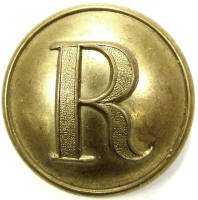
A virtual examination of artifacts of the American Civil War
 | Ridgeway Civil War Research Center,
A virtual examination of artifacts of the American Civil War |
| Civil War Artillery | |
| by Harry Ridgeway |
| Rifled artillery projectile, Britten design with Confederate adaptation, Confederate manufacture, bursting shell, pattern with short tapered nose, lead cup sabot, wood fuze, Confederate rifled 24 pounder, 5.8in. Projectile was manufactured in the Confederacy following the English Britten design. Manufacturing details suggesting Confederate manufacture include the relatively rough casting, mill marks on the base are prominent and crude, and it has a wood fuze. Confederate foundry is believed to have been Eason Brothers, Charleston South Carolina. All have been recovered from Charleston. The design employed a large lead cup sabot. Cast for wood fuze . Projectile measures: diameter 5.8in., length 9in. (excluding fuze), weight 28lb. (missing sabot). Research Center: Artillery3451-Britten, Ref: Bell, Heavy Ordnance, pg. 147. Details click: http://relicman.com/artillery/Artillery3451-Britten.html. |
| Ridgeway Civil War Research Center, A virtual examination of artifacts of the American Civil War. Artillery Research center, artillery, click: http://relicman.com/artillery/Artillery0000-Index.html. Research center, artillery, click: http://relicman.com/artillery/Artillery0000-Index.html. |
| Civil War Relicman, Harry Ridgeway, Civil War artillery, Relicman sales catalog. Click here: http://relicman.com/artillery/RelicmanSalesArtillery1.html. Artillery for sale: http://relicman.com/artillery/RelicmanSalesArtillery1.html. |